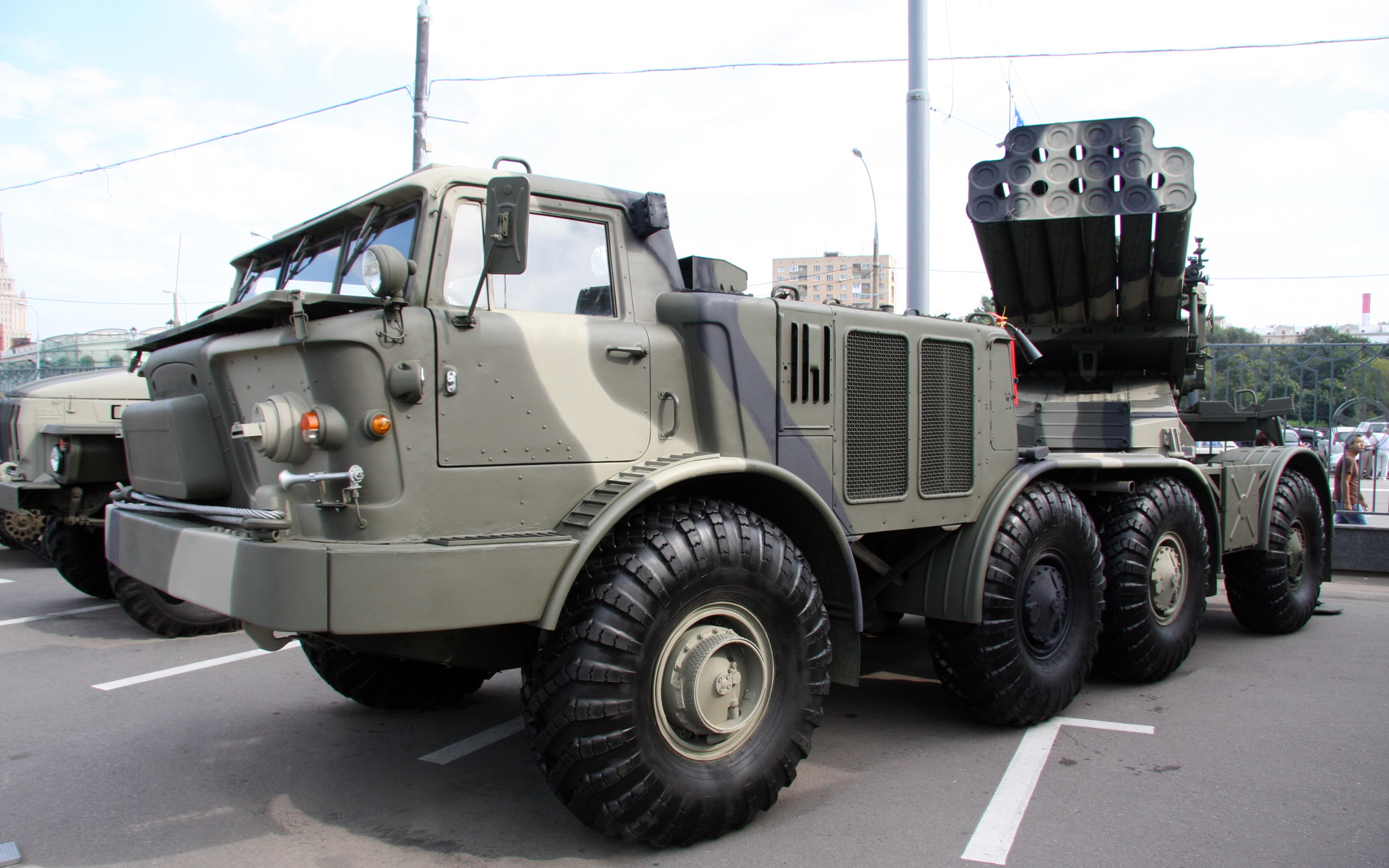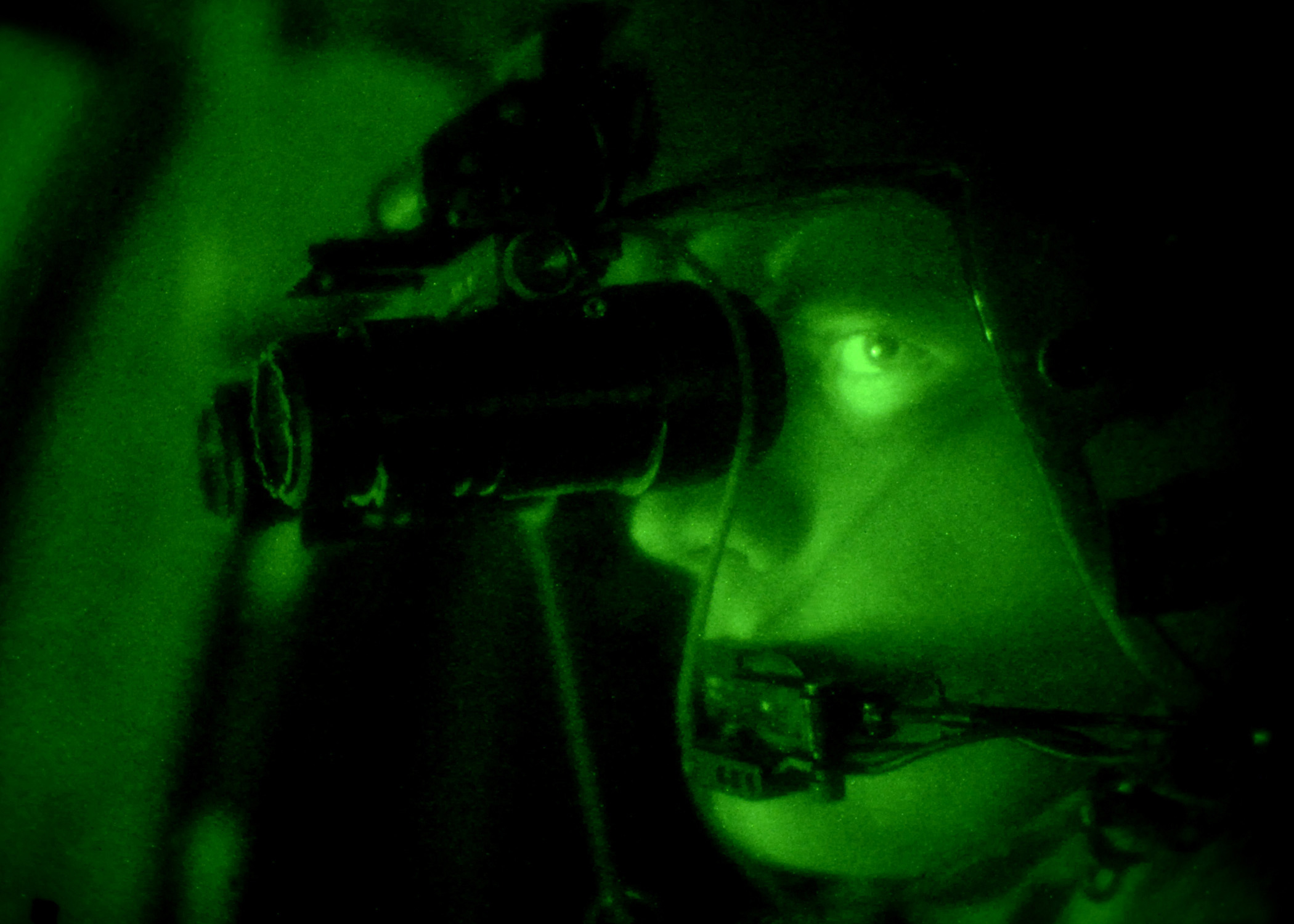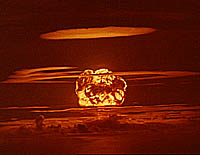|
Uragan-1M
The BM-27 Uragan (; GRAU index 9P140) is a self-propelled 220 mm multiple rocket launcher designed in the Soviet Union to deliver cluster munitions. The system began its service with the Soviet Army in the late 1970s, and was its first spin and fin stabilized heavy multiple rocket launcher. An updated version known as Uragan-1M was commissioned in 2008. The truck vehicle has no similarities. Description The BM-27 Uragan is capable of launching 220 mm rockets from 16 launch tubes mounted on the rear of a ZIL-135 8×8 chassis. This vehicle is extremely similar to that used in the FROG-7 free flight rocket system. It has two gasoline engines that power its 20 tonnes to a maximum speed of 65 kilometers per hour. One engine drives the four wheels on the left of the truck, while the other engine drives the four wheels on the right. The ZIL-135 has eight wheel drive, but only the front and rear axles are used for steering. It has a maximum cruising range of 500 kilometers. ... [...More Info...] [...Related Items...] OR: [Wikipedia] [Google] [Baidu] |
9К512 Uragan-1M
The 9K512 "Uragan-1M" is a Russian multicaliber (220 mm/300 mm) multiple rocket launcher with the ability to swap launch containers, allowing it to use the same missiles as the BM-30 Smerch and Tornado (multiple rocket launcher). It is a modernized version of the BM-27 Uragan. History In the mid-1990s, Russia began developing a new 9K512 Uragan-1M bi-caliber rocket system. In 1995, the Bryansk Automobile Plant started designing a chassis based on the BAZ-6910 "Voshchina-1" for the new MLRS. However, due to a lack of funding, all work on its design was stopped at the end of 1996. Simultaneously, the designers at Motovilikha Plants explored the option of basing the system on the MZKT-7930 "Astrolog" chassis. After reviewing the projects, the Ministry of Defense chose the option of placing wheeled tractors on a chassis produced by the Minsk Plant. In this form, the new Uragan-1M MLRS entered testing. In 2012, tests were conducted on the system. According to the state armament p ... [...More Info...] [...Related Items...] OR: [Wikipedia] [Google] [Baidu] |
GRAU Index
The Main Missile and Artillery Directorate of the Ministry of Defense of the Russian Federation (), commonly referred to by its transliterated acronym GRAU (), is a department of the Russian Ministry of Defense. It is subordinate to the Chief of Armament and Munition of the Russian Armed Forces, a vice-minister of defense. The organization dates back to 1862 when it was established under the name Main Artillery Directorate (, GAU). The "R" from "rockets" was added to the title from 19 November 1960. The GRAU is responsible for assigning GRAU indices to Russian army ammunitions and equipment. As of April 2025, the Chief of the GRAU was Major General Aleksey Volkov. Arsenals Arsenals of the GRAU, according to Kommersant-Vlast in 2005, included the 53rd at Dzerzhinsk, Nizhniy Novogorod Oblast, the 55th in the Sklad-40 microraion at Rzhev, the 60th at Kaluga, the 63rd at Lipetsk, the 75th at Serpukhov south of Moscow, and the 97th at Skolin (all five in the Moscow Military Di ... [...More Info...] [...Related Items...] OR: [Wikipedia] [Google] [Baidu] |
Night Vision Device
A night-vision device (NVD), also known as a night optical/observation device (NOD) or night-vision goggle (NVG), is an optoelectronic device that allows visualization of images in low levels of light, improving the user's night vision. The device enhances ambient visible light and converts near-infrared light into visible light which can then be seen by humans; this is known as I2 ( image intensification). By comparison, viewing of infrared thermal radiation is referred to as thermal imaging and operates in a different section of the infrared spectrum. A night vision device usually consists of an image intensifier tube, a protective housing, and an optional mounting system. Many NVDs also include a protective sacrificial lens, mounted over the front/ objective lens to prevent damage by environmental hazards, while some incorporate telescopic lens ... [...More Info...] [...Related Items...] OR: [Wikipedia] [Google] [Baidu] |
Night Vision
Night vision is the ability to see in low-light conditions, either naturally with scotopic vision or through a night-vision device. Night vision requires both sufficient spectral range and sufficient intensity range. Humans have poor night vision compared to many animals such as cats, dogs, foxes and rabbits, in part because the human eye lacks a tapetum lucidum, tissue behind the retina that reflects light back through the retina thus increasing the light available to the photoreceptors. Types of ranges Spectral range Night-useful spectral range techniques can sense radiation that is invisible to a human observer. Human vision is confined to a small portion of the electromagnetic spectrum called visible light. Enhanced spectral range allows the viewer to take advantage of non-visible sources of electromagnetic radiation (such as near-infrared or ultraviolet radiation). Some animals such as the mantis shrimp and trout can see using much more of the infrared and/or ... [...More Info...] [...Related Items...] OR: [Wikipedia] [Google] [Baidu] |
PG-1 Panoramic Telescope
The Explorer PG-1 Aqua Glider is an American single seat, biplane glider that was designed by Bill Skiliar in 1959 and made available as plans for amateur construction. The prototype was built with help from a troop of Air Explorer Scouts that same year.Said, Bob: ''1983 Sailplane Directory, Soaring Magazine'', page 40. Soaring Society of America November 1983. USPS 499-920 EAA AirVenture Museum, 2011, ''Skiliar Aqua Glider “Explorer” – N6498D'' http://www.airventuremuseum.org/collection/aircraft/Skliar Aqua Glider.asp, accessed 10 May 2011 Design and development Skiliar was a Colonel in the USAF and an aeronautical engineer and test pilot. He designed the Aqua Glider to be towed behind a boat, taking off from the water, releasing the tow rope and then gliding to a landing on the water. The Aqua Glider is made from wood and covered with doped aircraft fabric. The landing gear is fixed and consists of a pair of water skis. The aircraft uses spoilers instead of aileron ... [...More Info...] [...Related Items...] OR: [Wikipedia] [Google] [Baidu] |
NBC (weapon)
A weapon of mass destruction (WMD) is a biological, chemical, radiological, nuclear, or any other weapon that can kill or significantly harm many people or cause great damage to artificial structures (e.g., buildings), natural structures (e.g., mountains), or the biosphere. The scope and usage of the term has evolved and been disputed, often signifying more politically than technically. Originally coined in reference to aerial bombing with chemical explosives during World War II, it has later come to refer to large-scale weaponry of warfare-related technologies, such as biological, chemical, radiological, or nuclear warfare. Early usage The first use of the term "weapon of mass destruction" on record is by Cosmo Gordon Lang, Archbishop of Canterbury, in 1937 in reference to the bombing of Guernica, Spain: At the time, nuclear weapons had not been developed fully. Japan conducted research on biological weapons, and chemical weapons had seen wide battlefield use ... [...More Info...] [...Related Items...] OR: [Wikipedia] [Google] [Baidu] |
FROG-7
The 9K52 ''Luna-M'' (, ; NATO reporting name: Frog-7) is a Soviet short-range artillery rocket system which fires unguided and spin-stabilized 9M21 rockets. It was originally developed in the 1960s to provide divisional artillery support using tactical nuclear weapons but gradually modified for conventional use. The 9K52 was succeeded by the OTR-21 Tochka. Description Originally called the 3R-11 and 9R11, the 9M21 is a solid fuel rocket, with four off-angle vernier chambers immediately behind the warhead section. When the main engine section ignites, the verniers activate to start spinning the rocket, to improve stability and accuracy. At range, the 9M21 has a nominal CEP (circular error probable) of 400 meters.Soviet/Russian Armor and Artillery Design Practices: 1945-1995. (1995). United States: Marine Corps Intelligence Activity. V-57Soviet/Russian Armor and Artillery Design Practices: 1945-1995. V-58 Western intelligence estimated that its CEP at maximum range was 500 to 7 ... [...More Info...] [...Related Items...] OR: [Wikipedia] [Google] [Baidu] |
ZIL-135
The ZIL-135 is a large eight-wheeled military transport and Mobile launcher vehicle, self-propelled artillery truck manufactured by ZiL during the Cold War from the Soviet Union starting in 1959. Its purpose was to carry and launch a 9K52 Luna-M, Luna-M (NATO reporting name, NATO: Frog-7) surface-to-surface missile, surface-to-surface artillery rocket. The ZIL-135 was widely exported to other communist countries, most notably North Korea, where it is a common sight in films and military marches. It also served as the TEL for the BM-27 Uragan artillery rocket system. This vehicle has two gasoline engines that power its 20 tonnes to a maximum speed of . One engine drives the four wheels on the left of the truck, while the other engine drives the four wheels on the right. The ZIL-135 has eight wheel drive, but only the front and rear axles are used for steering. It has a maximum cruising range of . The cab of the ZIL-135 is NBC (weapon), NBC protected, allowing the rockets to be fi ... [...More Info...] [...Related Items...] OR: [Wikipedia] [Google] [Baidu] |
Rocket
A rocket (from , and so named for its shape) is a vehicle that uses jet propulsion to accelerate without using any surrounding air. A rocket engine produces thrust by reaction to exhaust expelled at high speed. Rocket engines work entirely from propellant carried within the vehicle; therefore a rocket can fly in the vacuum of space. Rockets work more efficiently in a vacuum and incur a loss of thrust due to the opposing pressure of the atmosphere. Multistage rockets are capable of attaining escape velocity from Earth and therefore can achieve unlimited maximum altitude. Compared with airbreathing engines, rockets are lightweight and powerful and capable of generating large accelerations. To control their flight, rockets rely on momentum, airfoils, auxiliary reaction engines, gimballed thrust, momentum wheels, deflection of the exhaust stream, propellant flow, spin, or gravity. Rockets for military and recreational uses date back to at least 13th-century China. ... [...More Info...] [...Related Items...] OR: [Wikipedia] [Google] [Baidu] |
Soviet Army
The Soviet Ground Forces () was the land warfare service branch of the Soviet Armed Forces from 1946 to 1992. It was preceded by the Red Army. After the Soviet Union ceased to exist in December 1991, the Ground Forces remained under the command of the Commonwealth of Independent States until it was formally abolished on 14 February 1992. The Soviet Ground Forces were principally succeeded by the Russian Ground Forces in Russian territory. Outside of Russia, many units and formations were taken over by the post-Soviet states; some were withdrawn to Russia, and some dissolved amid conflict, notably in the Caucasus. While the Ground Forces are commonly referred to in English language sources as the Soviet Army, in Soviet military parlance the term '' armiya'' (army) referred to the combined land and air components of the Soviet Armed Forces, encompassing the Ground Forces as well as the Strategic Rocket Forces, the Air Defence Forces, and the Air Forces. After World W ... [...More Info...] [...Related Items...] OR: [Wikipedia] [Google] [Baidu] |







